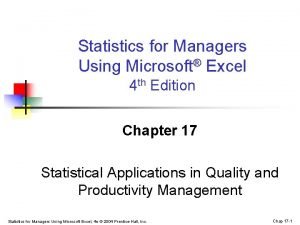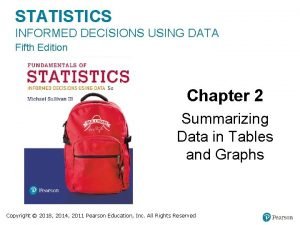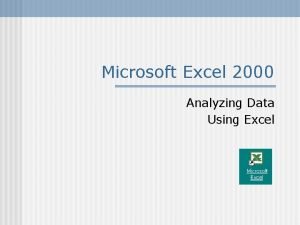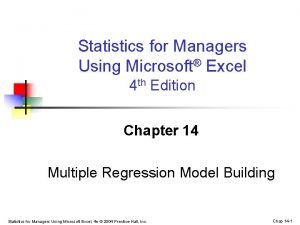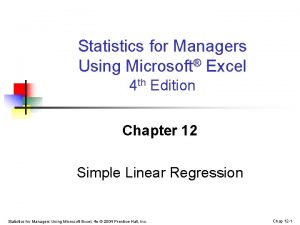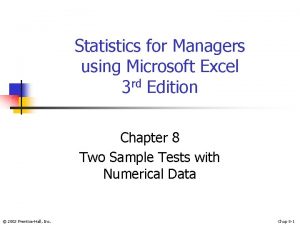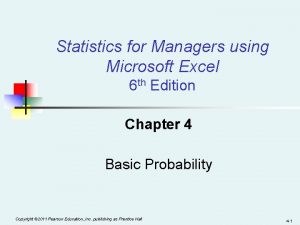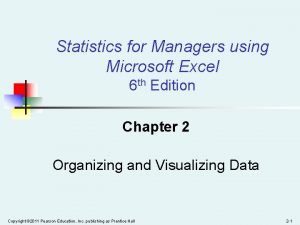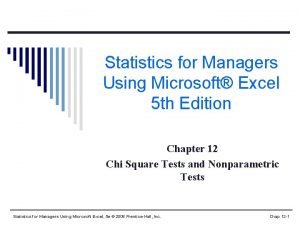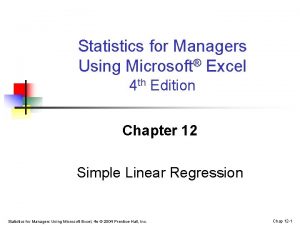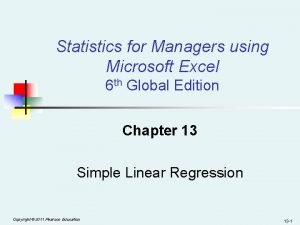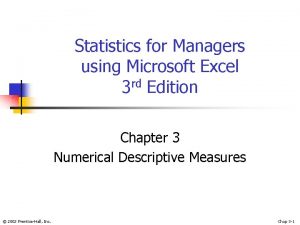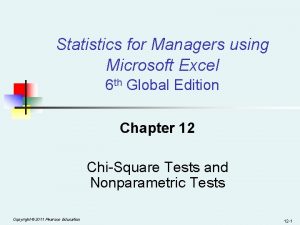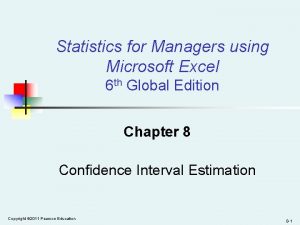Statistics for Managers Using Microsoft Excel 5 th



































- Slides: 35

Statistics for Managers Using Microsoft® Excel 5 th Edition Chapter 17 Decision Making Statistics for Managers Using Microsoft Excel, 5 e © 2008 Prentice-Hall, Inc. Chap 17 -1

Learning Objectives In this chapter, you learn: § To use payoff tables and decision trees to evaluate alternative courses of action § To use several criteria to select an alternative course of action § To use Bayes’ theorem to revise probabilities in light of sample information § About the concept of utility Statistics for Managers Using Microsoft Excel, 5 e © 2008 Prentice-Hall, Inc. 2

Steps in Decision Making § List Alternative Courses of Action § Choices or actions § List Uncertain Events § Possible events or outcomes § Determine ‘Payoffs’ § Associate a Payoff with Each Event/Outcome combination § Adopt Decision Criteria § Evaluate Criteria for Selecting the Best Course of Action Statistics for Managers Using Microsoft Excel, 5 e © 2008 Prentice-Hall, Inc. 3

Payoff Table A payoff table shows alternatives, states of nature, and payoffs Profit in $1, 000’s (Events) Strong Economy Stable Economy Weak Economy Investment Choice (Action) Large Average Small Factory 200 50 -120 Statistics for Managers Using Microsoft Excel, 5 e © 2008 Prentice-Hall, Inc. 90 120 -30 40 30 20 4

Decision Tree Large factory Average factory Small factory Strong Economy 200 Stable Economy 50 Weak Economy -120 Strong Economy 90 Stable Economy 120 Weak Economy -30 Strong Economy 40 Stable Economy 30 Weak Economy 20 Payoffs Statistics for Managers Using Microsoft Excel, 5 e © 2008 Prentice-Hall, Inc. 5

Opportunity Loss Opportunity loss is the difference between an actual payoff for an action and the optimal payoff, given a particular event Profit in $1, 000’s (Events) Strong Economy Stable Economy Weak Economy Investment Choice (Action) Large Factory Average Factory Small Factory 200 50 -120 90 120 -30 40 30 20 Payoff Table The action “Average factory” has payoff 90 for “Strong Economy”. Given “Strong Economy”, the choice of “Large factory” would have given a payoff of 200, or 110 higher. Opportunity loss = 110 for this cell. Statistics for Managers Using Microsoft Excel, 5 e © 2008 Prentice-Hall, Inc. 6

Opportunity Loss Investment Choice (Action) Profit in $1, 000’s (Events) Strong Economy Stable Economy Weak Economy Large Factory Average Factory Small Factory 200 50 -120 90 120 -30 40 30 20 Payoff Table Opportunity Loss Table Investment Choice (Action) Opportunity Loss in $1, 000’s (Events) Strong Economy Stable Economy Weak Economy Statistics for Managers Using Microsoft Excel, 5 e © 2008 Prentice-Hall, Inc. Large Factory Average Factory Small Factory 0 70 140 110 0 50 160 90 0 7

Decision Criteria § Expected Monetary Value (EMV) § The expected profit for taking action Aj § Expected Opportunity Loss (EOL) § The expected opportunity loss for taking action Aj § Expected Value of Perfect Information (EVPI) § The expected opportunity loss from the best decision Statistics for Managers Using Microsoft Excel, 5 e © 2008 Prentice-Hall, Inc. 8

Expected Monetary Value Goal: Maximize expected value § The expected monetary value is the weighted average payoff, given specified probabilities for each event Where EMV(j) = expected monetary value of action j Xij = payoff for action j when event i occurs Pi = probability of event i Statistics for Managers Using Microsoft Excel, 5 e © 2008 Prentice-Hall, Inc. 9

Expected Monetary Value § The expected value is the weighted average payoff, given specified probabilities for each event Profit in $1, 000’s (Events) Strong Economy (0. 3) Stable Economy (0. 5) Weak Economy (0. 2) Investment Choice (Action) Large Factory Average Factory Small Factory 200 50 -120 90 120 -30 40 30 20 Statistics for Managers Using Microsoft Excel, 5 e © 2008 Prentice-Hall, Inc. Suppose these probabilities have been assessed for these three events 10

Expected Monetary Value Payoff Table: Profit in $1, 000’s (Events) Strong Economy (0. 3) Stable Economy (0. 5) Weak Economy (0. 2) EMV (Expected Values) Investment Choice (Action) Large Factory Average Factory Small Factory 200 50 -120 90 120 -30 40 30 20 61 81 31 § Example: EMV (Average factory) = 90(. 3) + 120(. 5) + (-30)(. 2) = 81 Statistics for Managers Using Microsoft Excel, 5 e © 2008 Prentice-Hall, Inc. 11

Expected Opportunity Loss Goal: Minimize expected opportunity loss § The expected opportunity loss is the weighted average loss, given specified probabilities for each event Where EOL(j) = expected monetary value of action j Lij = opportunity loss for action j when event i occurs Pi = probability of event i Statistics for Managers Using Microsoft Excel, 5 e © 2008 Prentice-Hall, Inc. 12

Expected Opportunity Loss Table Investment Choice (Action) Opportunity Loss in $1, 000’s (Events) Large Factory Average Factory Small Factory Strong Economy (0. 3) Stable Economy (0. 5) Weak Economy (0. 2) 0 70 140 110 0 50 160 90 0 Expected Opportunity Loss (EOL) 63 43 93 § Example: EOL (Large factory) = 0(. 3) + 70(. 5) + (140)(. 2) = 63 Statistics for Managers Using Microsoft Excel, 5 e © 2008 Prentice-Hall, Inc. 13

Value of Information Expected Value of Perfect Information, EVPI § Expected Value of Perfect Information EVPI = Expected profit under certainty – expected monetary value of the best alternative § EVPI is equal to the expected opportunity loss from the best decision Statistics for Managers Using Microsoft Excel, 5 e © 2008 Prentice-Hall, Inc. 14

Expected Profit Under Certainty § Expected profit under certainty = expected value of the best decision, given perfect information Investment Choice (Action) Profit in $1, 000’s (Events) Strong Economy (0. 3) Stable Economy (0. 5) Weak Economy (0. 2) Value of best decision for each event: Large Factory Average Factory Small Factory 200 50 -120 90 120 -30 40 30 20 200 120 20 Example: Best decision given “Strong Economy” is “Large factory” Statistics for Managers Using Microsoft Excel, 5 e © 2008 Prentice-Hall, Inc. 15

Expected Profit Under Certainty Investment Choice (Action) Profit in $1, 000’s (Events) § Now weight these outcomes with their probabilities to find the expected profit under certainty: Strong Economy (0. 3) Stable Economy (0. 5) Weak Economy (0. 2) Large Factory Average Factory Small Factory 200 50 -120 90 120 -30 40 30 20 200 120 20 200(. 3)+120(. 5)+20(. 2) = 124 Statistics for Managers Using Microsoft Excel, 5 e © 2008 Prentice-Hall, Inc. 16

Value of Information Solution § Expected Value of Perfect Information (EVPI) EVPI = Expected profit under certainty – Expected monetary value of the best decision Recall: Expected profit under certainty = 124 EMV is maximized by choosing “Average factory, ” where EMV = 81 so: EVPI = 124 – 81 = 43 (EVPI is the maximum you would be willing to spend to obtain perfect information) Statistics for Managers Using Microsoft Excel, 5 e © 2008 Prentice-Hall, Inc. 17

Accounting for Variability Consider the choice of Stock A vs. Stock B Stock Choice (Action) Percent Return (Events) Stock A Strong Economy (. 7) 30 14 Weak Economy (. 3) -10 8 Expected Return (EMV) 18. 0 12. 2 Stock B Statistics for Managers Using Microsoft Excel, 5 e © 2008 Prentice-Hall, Inc. Stock A has a higher EMV, but what about risk? 18

Accounting for Variability Calculate the variance and standard deviation Stock Choice (Action) Percent Return (Events) Stock A Strong Economy (. 7) 30 14 Weak Economy (. 3) -10 8 Expected Return (EMV) 18. 0 12. 2 Variance 336. 0 7. 56 Standard Deviation 18. 33 2. 75 Stock B Example: Statistics for Managers Using Microsoft Excel, 5 e © 2008 Prentice-Hall, Inc. 19

Accounting for Variability Calculate the coefficient of variation for each stock: Stock A has much more relative variability Statistics for Managers Using Microsoft Excel, 5 e © 2008 Prentice-Hall, Inc. 20

Return-to-Risk Ratio (RTRR): Expresses the relationship between the return (expected payoff) and the risk (standard deviation) Statistics for Managers Using Microsoft Excel, 5 e © 2008 Prentice-Hall, Inc. 21

Return-to-Risk Ratio You might want to consider Stock B if you don’t like risk. Although Stock A has a higher Expected Return, Stock B has a much larger return to risk ratio and a much smaller CV. Statistics for Managers Using Microsoft Excel, 5 e © 2008 Prentice-Hall, Inc. 22

Decision Making with Sample Information § Permits revising old probabilities based on new information Prior Probability New Information Revised Probability Statistics for Managers Using Microsoft Excel, 5 e © 2008 Prentice-Hall, Inc. 23

Revised Probabilities Example Additional Information: Economic forecast is strong economy § When the economy was strong, the forecaster was correct 90% of the time. § When the economy was weak, the forecaster was correct 70% of the time. F 1 = strong forecast F 2 = weak forecast E 1 = strong economy = 0. 70 E 2 = weak economy = 0. 30 P(F 1 | E 1) = 0. 90 Prior probabilities from stock choice example P(F 1 | E 2) = 0. 30 Statistics for Managers Using Microsoft Excel, 5 e © 2008 Prentice-Hall, Inc. 24

Revised Probabilities Example Revised Probabilities (Bayes’ Theorem) Statistics for Managers Using Microsoft Excel, 5 e © 2008 Prentice-Hall, Inc. 25

EMV with Revised Probabilities Pi Event Stock A Xij. Pi . 875 strong 30 26. 25 14 12. 25 . 125 weak -10 -1. 25 8 1. 00 Σ = 25. 0 Revised probabilities Stock B Xij. Pi Σ = 13. 25 EMV Stock B = 13. 25 EMV Stock A = 25. 0 Statistics for Managers Using Microsoft Excel, 5 e © 2008 Prentice-Hall, Inc. Maximum EMV 26

EOL Table with Revised Probabilities Pi Event Stock A Xij. Pi Stock B . 875 strong 0 0 16 14. 00 . 125 weak 18 2. 25 0 0 Σ = 2. 25 Revised probabilities Xij. Pi Σ = 14. 00 EOL Stock B = 14. 00 EOL Stock A = 2. 25 Statistics for Managers Using Microsoft Excel, 5 e © 2008 Prentice-Hall, Inc. Minimum EOL 27

Accounting for Variability with Revised Probabilities Calculate the variance and standard deviation Stock Choice (Action) Percent Return (Events) Stock A Stock B Strong Economy (. 875) 30 14 Weak Economy (. 125) -10 8 Expected Return (EMV) 25. 0 13. 25 Variance 175. 0 3. 94 Standard Deviation 13. 229 1. 984 Example: Statistics for Managers Using Microsoft Excel, 5 e © 2008 Prentice-Hall, Inc. 28

Accounting for Variability with Revised Probabilities The coefficient of variation for each stock using the results from the revised probabilities: Statistics for Managers Using Microsoft Excel, 5 e © 2008 Prentice-Hall, Inc. 29

Return-to-Risk Ratio with Revised Probabilities With the revised probabilities, both stocks have higher expected returns, lower CV’s, and larger return to risk ratios Statistics for Managers Using Microsoft Excel, 5 e © 2008 Prentice-Hall, Inc. 30

Utility § Utility is the pleasure or satisfaction obtained from an action. § The utility of an outcome may not be the same for each individual. Statistics for Managers Using Microsoft Excel, 5 e © 2008 Prentice-Hall, Inc. 31

Utility Example Each incremental $1 of profit does not have the same value to every individual: §A risk averse person, once reaching a goal, assigns less utility to each incremental $1. §A risk seeker assigns more utility to each incremental $1. §A risk neutral person assigns the same utility to each extra $1. Statistics for Managers Using Microsoft Excel, 5 e © 2008 Prentice-Hall, Inc. 32

Utility Three Types of Utility Curves $ Risk Averter $ Risk Seeker Statistics for Managers Using Microsoft Excel, 5 e © 2008 Prentice-Hall, Inc. $ Risk-Neutral 33

Maximizing Expected Utility § Making decisions in terms of utility, not $ § Translate $ outcomes into utility outcomes § Calculate expected utilities for each action § Choose the action to maximize expected utility Statistics for Managers Using Microsoft Excel, 5 e © 2008 Prentice-Hall, Inc. 34

Chapter Summary In this chapter, we have § Described the payoff table and decision trees § Opportunity loss § Provided criteria for decision making § Expected monetary value § Expected opportunity loss § Return to risk ratio § Introduced expected profit under certainty and the value of perfect information § Discussed decision making with sample information § Addressed the concept of utility Statistics for Managers Using Microsoft Excel, 5 e © 2008 Prentice-Hall, Inc. 35
 Statistics for managers using ms excel solutions
Statistics for managers using ms excel solutions Microsoft official academic course microsoft excel 2016
Microsoft official academic course microsoft excel 2016 Microsoft excel merupakan program aplikasi .
Microsoft excel merupakan program aplikasi . Introduction to statistics what is statistics
Introduction to statistics what is statistics Statistics informed decisions using data 5th edition pdf
Statistics informed decisions using data 5th edition pdf Fspos vägledning för kontinuitetshantering
Fspos vägledning för kontinuitetshantering Novell typiska drag
Novell typiska drag Nationell inriktning för artificiell intelligens
Nationell inriktning för artificiell intelligens Ekologiskt fotavtryck
Ekologiskt fotavtryck Varför kallas perioden 1918-1939 för mellankrigstiden?
Varför kallas perioden 1918-1939 för mellankrigstiden? En lathund för arbete med kontinuitetshantering
En lathund för arbete med kontinuitetshantering Särskild löneskatt för pensionskostnader
Särskild löneskatt för pensionskostnader Personlig tidbok
Personlig tidbok Anatomi organ reproduksi
Anatomi organ reproduksi Vad är densitet
Vad är densitet Datorkunskap för nybörjare
Datorkunskap för nybörjare Tack för att ni lyssnade bild
Tack för att ni lyssnade bild Mall för debattartikel
Mall för debattartikel Delegerande ledarskap
Delegerande ledarskap Nyckelkompetenser för livslångt lärande
Nyckelkompetenser för livslångt lärande Påbyggnader för flakfordon
Påbyggnader för flakfordon Arkimedes princip formel
Arkimedes princip formel Svenskt ramverk för digital samverkan
Svenskt ramverk för digital samverkan Jag har gått inunder stjärnor text
Jag har gått inunder stjärnor text Presentera för publik crossboss
Presentera för publik crossboss Teckenspråk minoritetsspråk argument
Teckenspråk minoritetsspråk argument Vem räknas som jude
Vem räknas som jude Klassificeringsstruktur för kommunala verksamheter
Klassificeringsstruktur för kommunala verksamheter Epiteltyper
Epiteltyper Bästa kameran för astrofoto
Bästa kameran för astrofoto Cks
Cks Programskede byggprocessen
Programskede byggprocessen Mat för unga idrottare
Mat för unga idrottare Verktyg för automatisering av utbetalningar
Verktyg för automatisering av utbetalningar Rutin för avvikelsehantering
Rutin för avvikelsehantering Smärtskolan kunskap för livet
Smärtskolan kunskap för livet
